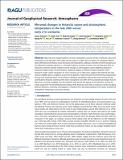Mirrored changes in Antarctic ozone and stratospheric temperature in the late 20th versus early 21st centuries
Author(s)
Santer, Benjamin; Fu, Qiang; Lin, Pu; Garcia, Rolando R.; Kinnison, Doug; Mills, Michael; Solomon, Susan; Ivy, Diane J; Gupta, Mukund; Bandoro, Justin; ... Show more Show less
DownloadMirrored changes in Antarctic ozone.pdf (3.707Mb)
PUBLISHER_POLICY
Publisher Policy
Article is made available in accordance with the publisher's policy and may be subject to US copyright law. Please refer to the publisher's site for terms of use.
Terms of use
Metadata
Show full item recordAbstract
Observed and modeled patterns of lower stratospheric seasonal trends in Antarctic ozone and temperature in the late 20th (1979–2000) and the early 21st (2000–2014) centuries are compared. Patterns of pre‐2000 observed Antarctic ozone decreases and stratospheric cooling as a function of month and pressure are followed by opposite‐signed (i.e., “mirrored”) patterns of ozone increases and warming post‐2000. An interactive chemistry‐climate model forced by changes in anthropogenic ozone depleting substances produces broadly similar mirrored features. Statistical analysis of unforced model simulations (from long‐term model control simulations of a few centuries up to 1000 years) suggests that internal and solar natural variability alone is unable to account for the pattern of observed ozone trend mirroring, implying that forcing is the dominant driver of this behavior. Radiative calculations indicate that ozone increases have contributed to Antarctic warming of the lower stratosphere over 2000–2014, but dynamical changes that are likely due to internal variability over this relatively short period also appear to be important. Overall, the results support the recent finding that the healing of the Antarctic ozone hole is underway and that coupling between dynamics, chemistry, and radiation is important for a full understanding of the causes of observed stratospheric temperature and ozone changes.
Date issued
2017-08Department
Massachusetts Institute of Technology. Department of Earth, Atmospheric, and Planetary SciencesJournal
Journal of Geophysical Research: Atmospheres
Publisher
American Geophysical Union (AGU)
Citation
Solomon, Susan, Diane Ivy, Mukund Gupta, Justin Bandoro, Benjamin Santer, Qiang Fu, Pu Lin, Rolando R. Garcia, Doug Kinnison, and Michael Mills. “Mirrored Changes in Antarctic Ozone and Stratospheric Temperature in the Late 20th Versus Early 21st Centuries.” Journal of Geophysical Research: Atmospheres 122, no. 16 (August 23, 2017): 8940–8950. © 2017 American Geophysical Union.
Version: Final published version
ISSN
2169-8996
2169-897X